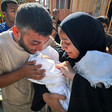Rights and Accountability 25 October 2016
A United Nations agency is calling for humanitarian access to an embattled refugee camp in the rural outskirts of Damascus after four Palestinian refugees were killed, along with a Syrian woman, while trying to flee last week.
“Nofeh Mohammed Jarad, who was in her sixties, her daughter Ibaa Saeed al-Nader, 22, their driver and a 1-year-old baby were all killed when their vehicle was shelled” the night of 18 October, stated UNRWA, the UN agency for Palestine refugees. “The mother of the baby, a Syrian citizen, also died in the incident.”
A rescue worker in the camp told The Electronic Intifada that the five were killed while attempting to leave the camp on the unpaved Zakia road, the only way in and out of the camp which has been subjected to increasing restrictions by the Syrian army.
Zakia has been dubbed “Death Road” by Khan Eshieh residents as it has been repeatedly targeted by shelling and sniper fire.
“Death Road”
“Families that want to go out, or refugees who want to go get bread or medicine use this bumpy road only at night, risking both crashes and shelling,” said the rescue worker, who asked for his real name not to be published for fear of his safety, and wished to be identified as Omar al-Muslim.
“Cars that want to get out are covered with clay in order to avoid being noticed and they only leave at night. Last week one truck that was planning to drive to Zakia to bring bread crashed into a valley,” he added.
Al-Muslim said that the car transporting the five civilians was hit from a hilltop controlled by the Syrian army.
“Recovering the corpses was very dangerous, because the paramedics and the volunteers were under constant shelling,” al-Muslim added, saying one person survived the attack and that a volunteer with the Jafra Foundation, a group that provides services to Palestinians in Syrian refugee camps, was among those killed.
Two Jafra volunteers were previously killed this month when Russian warplanes dropped cluster munitions on the camp, and another volunteer was killed by a cluster bomb while clearing the camp’s streets of waste two months earlier, according to the group.
The estimated 8,000 remaining residents of Khan Eshieh, which had a population of more than 20,000 before the war, are unable to leave without risking their lives.
“Tightened security around the area has severely reduced the ability of residents to move safely and readily access humanitarian aid and medical support. Camp residents face grave risks when attempting to leave Khan Eshieh,” UNRWA stated.
The agency added that access to the camp to deliver humanitarian assistance has been “constrained” since 2013, and that it is “particularly concerned about a lack of medicine and the impact this will have on children, chronic disease patients and the elderly in Khan Eshieh.”
At least 31 Palestinian refugees in Khan Eshieh have been killed since May 2016, when armed conflict intensified in the area, according to UNRWA.
“Another Yarmouk”
With access to the camp severely restricted, the agency warned of the “real risk” of Khan Eshieh “becoming another Yarmouk.”
Once home to 150,000 residents, Yarmouk, the southern gateway to Damascus, was formerly the largest Palestinian population center in the country before it became an arena of fighting in December 2012. Thousands fled after rebel forces entered the camp and its central mosque was hit in government airstrikes.
Since then, electricity and water supplies to the camp have been cut and a complete siege was imposed by government forces and allied groups in July 2013. Dozens in the camp starved to death that following winter, and many more have been killed during clashes and ongoing shelling and strikes on Yarmouk. Islamic State fighters seized the camp earlier this year.
A media activist in Khan Eshieh told The Electronic Intifada earlier this month that “The latest escalation began following a massive offensive by the Syrian army, backed by Russian jets, to retake the nearby towns of Deir Khabiyeh and al-Muqayliba.”
“Although we insist on the neutrality of the camp and that there are absolutely no fighters or military presence by the opposition inside, we continue to pay the price,” the activist added.
No hospital
The camp’s only hospital is no longer functional and there are only paramedics to offer first aid, and no doctors to perform surgeries, according to the rescue worker who had responded to the scene where the five were killed while trying to leave Khan Eshieh last week.
“There have been many cases where they were forced to amputate legs simply because they have no equipment or doctors to carry out surgeries,” al-Muslim said.
A field hospital outside the camp is constantly being shelled, making it too risky to transport the wounded for treatment there, and nurses living in Khan Eshieh employed in state-run hospitals run the risk of arrest if they treat anyone injured by shelling, according to al-Muslim.
Bread and medicine that makes it into the camp is sold at inflated prices, he added.
Khan Eshieh and Yarmouk are not the only camps to be engulfed by the ongoing war in Syria.
According to UNRWA, “Out of the 12 Palestine refugee camps throughout the country, five are destroyed or inaccessible to the agency.”
More than 60 percent of the 450,000 Palestinian refugees living in Syria have “experienced prolonged internal displacement, relocating several times over the years,” UNRWA added.
The agency is the largest humanitarian aid provider for Palestinian refugees in Syria, 95 percent of whom depend on its assistance.
UNRWA says that 60 percent of its installations around the country have been rendered inaccessible, with 57 schools badly damaged or destroyed, during the more than five years of violence in Syria.
Budour Youssef Hassan contributed reportage.




